We’ve talked about bodegones before – the Argentine spots that serve up classic fare, and often as traditional to their regional origins as they can be. Almost always very casual spots. Today, we dive into three different ones that we’ve been to recently.
We’ll start at La Aguada, Billinghurst 1862, Recoleta. One of those places we’ve passed by a zillion times and never stopped in. On the surface, it seems an odd name for a restaurant – aguada means something watery, or a place where there’s water available. In slang terms it refers to a person who’s lacking in enthusiasm and/or energy. Not exactly a draw for a restaurant. But here it refers to the northwestern Argentina culture La Aguada, that existed roughly from 600-900 CE, and centered around a town of the same name. It’s been recognized for about 60 years now as a distinct culture from others in the surrounding provinces of Catamarca and La Rioja. And, not surprisingly, the food here focuses on the cuisine of northwest Argentina. Henry and I headed there with a visiting friend.
Good empanadas – we particularly liked the vegetable ones – a mix of seasonal vegetables in a creamy sauce; though, the four cheese and the spicy beef were pretty damned good too.
A classic locro, packed with corn, squash, beans, and different meats.
And one of the few places around that serves carbonada, another of the four classic stews of northern Argentina, with veal, dried peaches, and vegetables. I don’t know why it’s not as popular as the other three (locro, mondongo, lentejas).
Tasty as they were, we like our spice, and asked if they had hot sauce. Boy did they! That had one hell of a kick.
Bifes a la criolla – not what any of us at the table think of as this dish, but that may be either a regional thing, or a chef’s personal interpretation. For us it was missing all the vegetables and sauce that we’re used to seeing and was a bit bland. The way I learned to make it, and generally see it served, here.
And, we finished off sharing a common dessert – slabs of creamy cheese, usually served with either quince or sweet potato paste, here offered with either honey from the region, or, a squash called chayote, which is not the same as a chayote in English, which is the mirliton or christophene, here called a papa del aire, or air potato. This is the “figleaf squash”, usually in Spanish called the chilacayote, but in Argentina, just chayote… whew. It has a texture almost like spaghetti squash, and here it’s candied and ladled over the cheese.
Overall, we like the place, service, most of the food, and the low prices. We’ll definitely be back.
This one was a solo visit. Pa’l Que Guste, Talcahuano 949, Retiro – the name means “for whatever you like”, and while the menu’s not as comprehensive as that sounds, it’s a decent selection of classic local dishes.
Had to start with empanadas, of course – and the spicy beef had a good kick, and the mushroom one was flavorful and a really good mix of mushrooms and onions. The crust on the empanadas is a bit thick for my personal tastes, and some reviewers have commented that it makes it seem like there’s not enough filling. There is, but the ratio between dough and filling just feels off for an empanada, tasty as it they are – almost like a pasty.
Off-hand, I don’t know what region this place claims as its primary focus. This is one of the more unusual Argentine locros that I’ve had. It’s almost entirely cracked corn, with white beans, bacon, a sort of salami-like sausage, a couple of cuts of beef, and lots of green onion. It’s good, but I missed the mix of squash, potato, tomato, etc., that I usually encounter in locro here. Then again, in my “L-Word” project of exploring regional locros, I’ve still got dozens to go, and I may find one just like this from one or another region. I should get back to that project, along with the international bread and soup one. They did have hot sauce available, and again, a really fiery one, but it perked this stew up really nicely.
Like the place, service is friendly, though the kitchen is a bit slow – then again, the place was packed with people waiting for tables, so that could be a timing thing, prices quite reasonable. Another that I’d happily go back to.
In retrospect, a holiday may not have been the best day to choose for going to a neighborhood bodegón. Roque, Inclán 3999, in Boedo, was jam-packed with people waiting, when the Horde arrived. Yet, somehow, we managed to get a table for five. Though, while our waitress was friendly, she was so overworked, and the kitchen was so slow trying to keep up, that overall, it was a moderately rough experience. It was slow enough that a couple of tables just stood up and left, apparently some without paying for what they did eat. At the table next to us, the exaggerated anger over having to wait for food devolved into pouring what was left of their wine and water all over the table before storming off, knocking a chair to the ground. Just childish behavior directed against waitstaff that had no control over the speed of the kitchen or the number of patrons dining.
We started off splitting an order of fried calamari – quite good. Nice and tender, a well-seasoned batter, and it actually arrived within minutes of ordering it. A bottle of the house wine, pictured above, was actually pretty decent – and surprisingly, the winelist is beyond reasonably priced – most of the wines being offered at or awfully close to retail prices.
Unfortunately, we then waited. And waited. Our main courses arrived an hour and a quarter after we ordered them. To her credit, our waitress kept us relatively updated on what was going on – there was clearly nothing she could do about it, and she was serving tables as fast as stuff ground out of the kitchen.
Roque is known for their parrilla dishes and their pasta dishes. Then again, that’s about 3/4 of the menu. An order of penne with a bacon and green onion cream sauce was nicely flavored, though the cream sauce was more likely a milk-based bechamel, a bit light, and the pasta itself was overcooked. Well, that’s practically a given in bodegones in Buenos Aires.
A couple of steaks – a hanger steak and a tenderloin steak – cooked nicely in the rare to medium rare range. Good quality meat, lightly salted, decent potato sides (one mashed, one “español”).
This, however, was the raison d’être for having picked Roque in the first place. I’d read about the Alfajor Roque somewhere along the line. Now, an alfajor is, almost universally, a dessert – a giant sandwich cookie, usually with dulce de leche, chocolate, or jam between two cookies, and often then bathed in a chocolate shell. Sort of a large mutant cross between an Oreo and a Ding Dong. Here, however, what remains is the general design form of the idea. What arrives is a large provolone covered puck of…
…layered meats and cheese. Four layers of thin cut sirloin, like a milanesa without the breading, interleaved with slices of provolone, ham, and bacon. It’s a bit of overkill, though if you actually analyzed it, there’s probably less meat than simply ordering a steak, and there’s really not all that much cheese – certainly not as much as if you ordered and ate a provoleta appetizer. The flavor is fine, but the two of us who ordered one of these found the whole thing to be dry and overcooked. Whether that was a simple case of the travails of the kitchen on this day that wasn’t going well, or its normal state, we can’t say, but we weren’t wowed.
Would we go back? Probably not. Nothing was bad, and it was interesting mostly to try the alfajor but not enough so to warrant a return visit. There are too many bodegones out there that serve better food. It was quite reasonably priced – all of the above, plus an additional bottle of wine, two large bottles of water, came in at 15,580 pesos for five of us, 3116 apiece, we upped it to 3500 with the tip – at the blue rate just over $12 each.
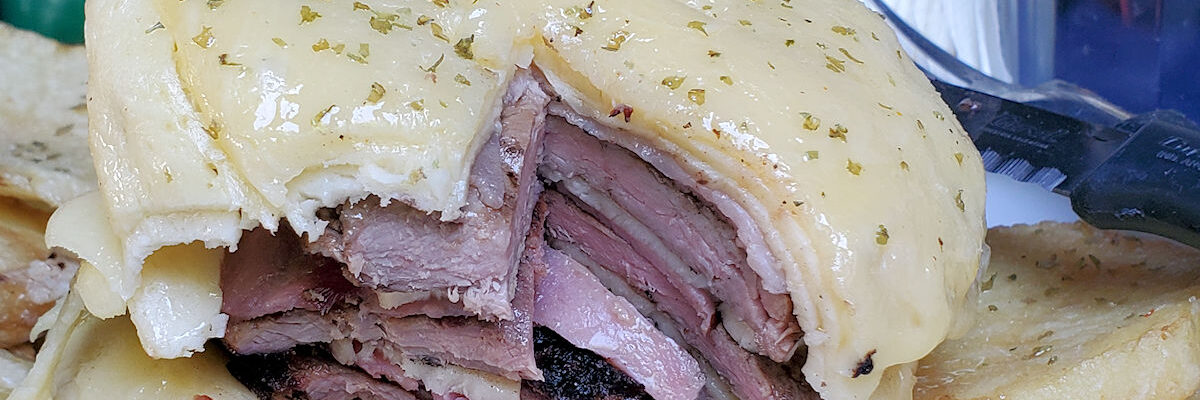
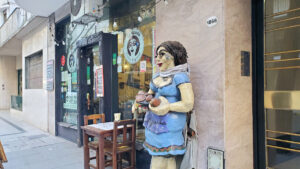
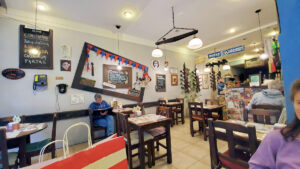
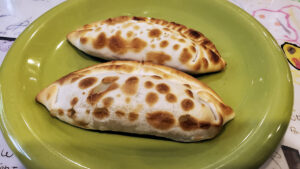
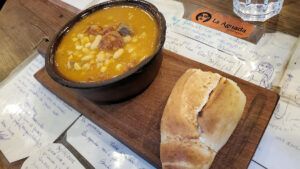
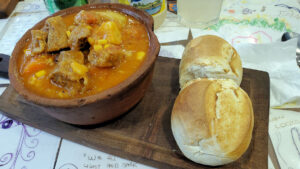
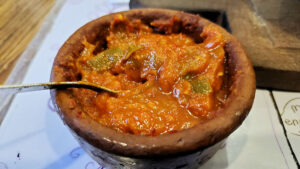
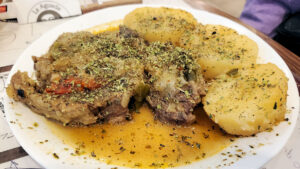
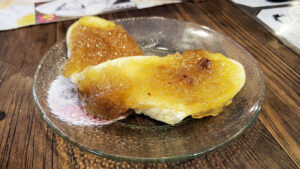
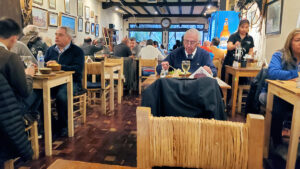
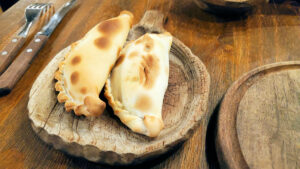
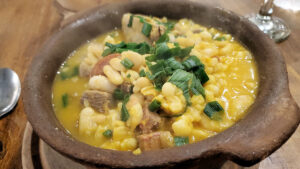
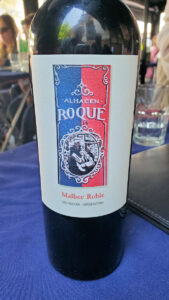
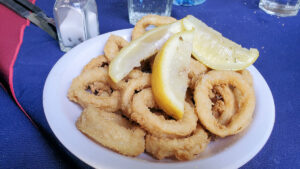

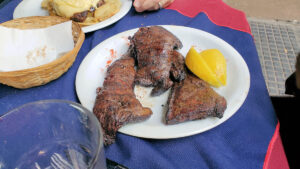
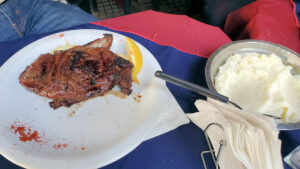
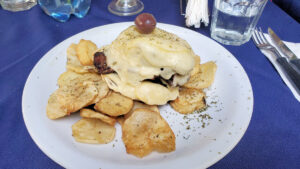
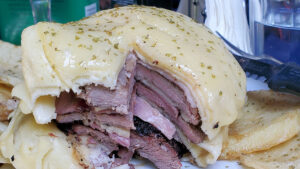
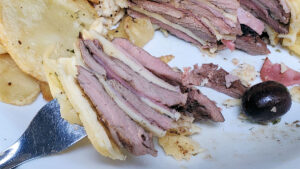
This has gotten me in the mood for locro!
Is your recipe for Loco Criollo still the same one that’s listed here, or has it changed over time? https://www.saltshaker.net/20050804/locro-revisited
Thanks in advance!
That’s pretty much still the way I make locro criollo. Minor tweaks here and there, and sometimes wing it based on what I have available. But also, worth exploring are some of the other locros that we’ve explored on our “L Word” page, with more to come!